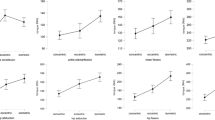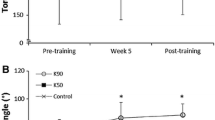Abstract
The purpose of this study was to examine the effects of unilateral isometric leg extension strength training on the strength and integrated electromyogram (IEMG) of both the trained and untrained limbs at multiple joint angles. A training (TRN) group [nine women; mean (SD) age, 20(1) years] exercised for 6 weeks with isometric leg extensions at 80% of maximal isometric torque. A control (CTL) group [eight women; 21(1) years] did not exercise. The training was performed three times per week on a Cybex II isokinetic dynamometer at a joint angle where the lever arm was 0.79 rad below the horizontal plane. The subjects were tested pre- and posttraining for maximal unilateral isometric torque in both limbs at joint angles of zero, 0.26, 0.79,1.31, and 1.57 rad below the horizontal plane. Bipolar surface electrodes were used to record the IEMG of the vastus lateralis (VL) and vastus medialis (VM) during the isometric tests. Three univariate (torque, IEMG-VL, and IEMG-VM) four-way (group x time x limb x angle) mixed factorial ANOVAs were used to analyze the data. The results indicated joint angle specificity for isometric torque in the TRN group only, with significant increases in torque at 0.79 (P = 0.0004) and 1.31 (P = 0.0039) rad. No significant increases in torque were found in the untrained limb of the TRN group or in either limb of the CTL group. Similarly, there were no significant changes in IEMG as a result of the training for the VL or VM. The joint-angle-specific strength increases without concomitant increases in IEMG were hypothesized to result from joint-angle-specific decreases in antagonistic co-contraction and/or preferential hypertropy of the quadriceps femoris at specific levels of the muscle group.
Similar content being viewed by others
References
Brown AB, McCartney N, Sale DG (1990) Positive adaptations to weight-lifting in the elderly. J Appl Physiol 69: 1725–1733
Cabric M, Appell HJ (1987) Effect of electrical stimulation of high and low frequency on maximum isometric force and some morphological characteristics in man. Int J Sports Med 8: 256–260
Cannon RJ, Cafarelli E (1987) Neuromuscular adaptations to training. J Appl Physiol 63: 2396–2402
Carolan B, Cafarelli E (1992) Adaptations in coactivation after isometric resistance training. J Appl Physiol 73: 911–917
deVries HA, Housh TJ, Johnson GO, Evans SA, Tharp GD, Housh DJ, Hughes RA (1990) Factors affecting the estimation of physical working capacity at the fatigue threshold. Ergonomics 33: 25–33
Enoka RM (1988) Muscle strength and its development. Sports Med 6: 146–168
Garfinkel S, Cafarelli E (1992) Relative changes in maximal force, EMG, and muscle cross-sectional area after isometric training. Med Sci Sports Exerc 24: 1220–1227
Housh DJ, Housh TJ, Johnson GO, Chu W (1992) Hypertrophic response to unilateral concentric isokinetic resistance training. J Appl Physiol 73: 65–70
Houston ME, Froese EA, Valeriote SP, Green HJ, Ranney DA, (1983) Muscle performance, morphology and metabolic capacity during strength training and detraining: a one leg model. Eur J Appl Physiol 51: 25–35
Ikai M, Fukunaga T (1970) A study on training effect on strength per unit cross-sectional area of muscle by means of ultrasonic measurement. Int Z Angew Physiol 28: 173–180
Jones DA, Rutherford OM (1987) Human muscle strength training: the effects of three different regimes and the nature of the resultant changes. J Physiol (Lond) 391: 1–11
Keppel G (1982) Design and analysis. A researcher's handbook, 2nd edn. Prentice Hall, Engelwood Cliffs N.J., p 472
Kitai TA, Sale DG (1989) Specificity of joint angle in isometric training. Eur J Appl Physiol 58: 744–748
Knapik JJ, Mawdsley RH, Ramos MU (1983) Angular specificity and test mode specificity of isometric and isokinetic strength training. J Orthop Sports Phys Ther 5: 58–65
Komi PV, Viitasalo JT, Rauramaa R, Vihko V (1978) Effect of isometric strength training on mechanical, electrical, and metabolic aspects of muscle function. Eur J Appl Physiol 40: 45–55
Krotkiewski M, Aniansson A, Grimby G, Bjorntorp P, Sjostrom L (1979) The effect of unilateral isokinetic strength training on local adipose and muscle tissue morphology, thickness, and enzymes. Eur J Appl Physiol 42: 271–281
Laughman RK, Yates JW, Garrett TR, Chao EYS (1983) Strength changes in the normal quadriceps femoris muscle as a result of electrical stimulation. Phys Ther 63: 494–499
Lindh M (1979) Increase of muscle strength from isometric quadriceps exercises at different knee angles. Scand J Rehabil Med 11: 33–36
Moritani T (1992) Time course of adaptations during strength and power training. In: Komi PV (ed) Strength and power in sport. Blackwell, Oxford, pp 266–278
Moritani T, deVries HA (1979) Neural factors versus hypertrophy in the time course of muscle strength gain. Am J Phys Med 58: 115–130
Narici MV, Roi GS, Landoni L, Minetti AE, Cerretelli P (1989) Changes in force, cross-sectional area, and neural activation during strength training and detraining of the human quadriceps. Eur J Appl Physiol 59: 310–319
Patton NJ, Mortensen OA (1971) An electromyographical study of reciprocal activity of muscles. Anat Rec 170: 225–268
Rutherford OM, Jones DA (1986) The role of learning and coordination in strength training. Eur J Appl Physiol 55: 100–105
Sale DG (1992) Neural adaptation to strength training. In: Komi PV (ed) Strength and power in sport. Blackwell, Oxford, pp 249–265
Shaver LG (1975) Cross transfer effects on conditioning and deconditioning on muscular strength. Ergonomics 18: 9–16
Tesch PA, Karlsson J (1984) Effects of exhaustive, isometric training on lactate accumulation in different muscle fiber types. Int J Sports Med 5: 89–91
Thepaut-Mathieu C, Van Hoecke J, Maton M (1988) Myoelectrical and mechanical changes linked to length specificity during isometric training. J Appl Physiol 64: 1500–1505
Thorstensson A, Karlsson J, Viitasalo JHT, Luhtanen P, Komi PV (1976) Effect of strength training on the EMG of human skeletal muscle. Acta Physiol Scand 98: 232–236
Tyler AE, Hutton RS (1986) Was Sherrington right about co-contractions? Brain Res 370: 171–175
van Zuylen EJ, van Gielen CCAM, Denier van der Gon JJ (1988) Coordination and inhomogenous activation of human arm muscles during isometric torques. J Neurophysiol 60: 1523–1548
Weir JP, Housh TJ, Weir LL (1994) Electromyographic evaluation of joint angle specificity and cross-training after isometric training. J Appl Physiol 77: 197–201
Zipp P (1982) Recommendations for the standardization of lead positions in surface electromyography. Eur J Appl Physiol 50: 41–54
Author information
Authors and Affiliations
Rights and permissions
About this article
Cite this article
Weir, J.P., Housh, T.J., Weir, L.L. et al. Effects of unilateral isometric strength training on joint angle specificity and cross-training. Europ. J. Appl. Physiol. 70, 337–343 (1995). https://doi.org/10.1007/BF00865031
Accepted:
Issue Date:
DOI: https://doi.org/10.1007/BF00865031




